Quilter’s First Statue
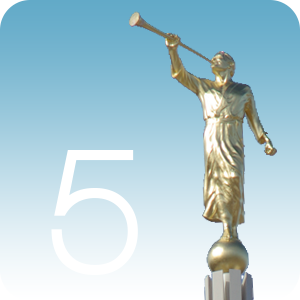
| COMMISSIONED | 1978, sculpted ~1982 |
| MATERIAL | Fiberglass covered in 22 karat gold leaf |
| HEIGHT | 7’ (2.1 Meters) |
| WEIGHT | ~300 lbs. (181.4 kilograms) |
| CURRENTLY ON | 97 Temples |
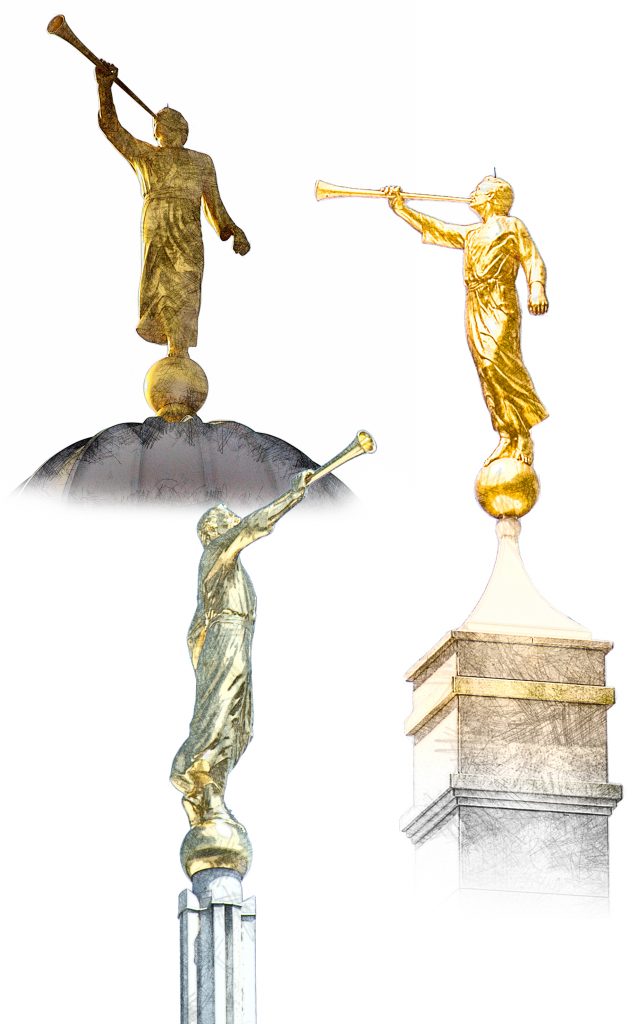
A New Standard
In the 1970’s the Church commissioned Karl Quilter to create a new fiberglass standard that could be deployed to all the new temples President Kimball had announced.[1]Stecklein, Janelle, “Utah sculptor of Mormon Angel Moroni statues dies at 84,” Salt Lake Tribune, 13 December 2013. The Church requested a statue from Quilter that would be more akin to the Dallin statue. They wanted the statue to be one in an act of proclamation, rather than delivering a set of plates. Karl came to the conclusion that the “everlasting Gospel” that the angel in the book of revelation was carrying had to be more than just what was in the Book of Mormon. He decided the best way to focus on proclamation instead of delivery was to not have the statue carry places at all, as the two previous statues had done.[2]Rosner, Jannalee, “”Super Moroni” Statue Almost Appeared on Nauvoo Temple, Sculptor’s Son Recalls.” LDS Living, Mormon Life, 28 October 2016. Initially, 20 of this statue were ordered before the decision was made to ask for a second, larger statue as well.[3]“Sculptor’s Works Top Temple Towers Worldwide,” Ensign, April 2006.
Creation
Karl’s Method was a little different from some of those who had come before. His mentor, Avard Fairbanks, had started with wood frame, wrapped with wire mesh to create a basic starting shape, and then piled on clay until reaching a mass that looked about right. Like Fairbanks and Malin, Karl was a student of anatomy. However, instead of a mass of clay, Karl would start with a wood frame, or mandril, that was more like a skeleton, and would then model each and every muscle, building up in layers and ensuring the final form was correct in mass and proportion.[4]“Sculptor’s Works Top Temple Towers Worldwide.” The Church of Jesus Christ of Latter-Day Saints, The Church of Jesus Christ of Latter-Day Saints, Apr. 2006. After ensuring the body was correct, strips of clay would be draped like cloth to shape the clothing on the statue.[5]Ostler, Shannon W. “How Moroni Statues Are Made.” The Church of Jesus Christ of Latter-Day Saints, The Church of Jesus Christ of Latter-Day Saints, Feb. 1987.
The full size clay statue was carved on site at Wallgren’s studio in Kearns Utah. LaVar Wallgren would than create seams across the surface of the clay statue. This he did by embedding strips of metal in the surface of the clay. This ensured that the mold could be split apart after it was created. Polyester fiberglass resin would then be sprayed directly over the clay statue. Once the mold had hardened, it was pulled apart at the previously created seams. Unlike the plaster case method, this fiberglass shell was hard, but less fragile. The disadvantage was that it stuck to the clay, destroying the statue when removed. Once the clay was scooped out of the individual mold sections they could be pieced together to make larger components, much like previous plaster cases. These were then filled with fiberglass to make segments of the statue. As with its metal predecessors, the finished statue segments would then be pieced together to form the final statue.[6]Ostler, Shannon W. “How Moroni Statues Are Made.” The Church of Jesus Christ of Latter-Day Saints, The Church of Jesus Christ of Latter-Day Saints, Feb. 1987. The seams are cleaned up, and the entire surface of the statue sandblasted to give an even, ready surface for gilding with two layers of gold leaf. [7]Hart, J. L. (1983, September 7). Statues Sculpted in fiberglass. The Church News, pp. 8-13.[8]Ostler, Shannon W. “How Moroni Statues Are Made.” The Church of Jesus Christ of Latter-Day Saints, The Church of Jesus Christ of Latter-Day Saints, Feb. 1987.
Unlike those that had come before, the entire statue, from creation to casting, was done at one location, with no need to ship it across country to a foundry.[9]Ostler, Shannon W. “How Moroni Statues Are Made.” The Church of Jesus Christ of Latter-Day Saints, The Church of Jesus Christ of Latter-Day Saints, Feb. 1987.
Design
The new statue was 7 feet, head to heel. Like the Dallin Statue, this new Quilter Statue had the trumpet in a firm grasp, elbow bent, trumpet pressed firmly to the lips. The trumpet is held about 45 degrees or so to the right. The statue is dressed in a flowing robe, with fewer layers than the Dallin statue. There is no cap, but overall the statue has a higher level of detail. Quilter’s work tends to the realistic, sculpted with deep contrast so that the details stand out. This style is more akin to Millard Malin’s style, having sharper, crisper details than the Dallin Statue. It is very different from the sculpture carved by his University Teacher, mentor and friend Avard Fairbanks, which is more abstract in style.
The quickest way to identify this statue is to look at it from the front. The hem of the robe on this statue is windswept and blows out and away from the feet to the viewer’s left. The statue’s left hand is held away from the body at a greater angle than the other two Quilter statues. The left wrist is bent down. The robe on the left sleeve is smoother, devoid of defined wrinkles, and the cuff hangs round and loose on that arm. The left leg bends back at the knee, projecting the knee forward slightly in front of the chest.
Seen from the side, the left arm is bent forward at the elbow. The left hand is clenched in a fist.
Close up on the right hand, the fingers holding the trumpet are spaced apart. The thumb overlaps the pointer finger and touches the middle finger.
The underside of this statue is signed by K Quilter and LV Wallgren.[10]Based upon personal observation.
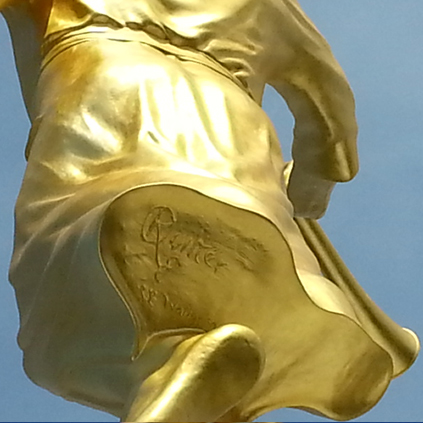
First Placement
This statue was first placed upon the Nuku’alofa Tonga Temple 8 January 1983, being the second fiberglass statue ever placed atop a temple.
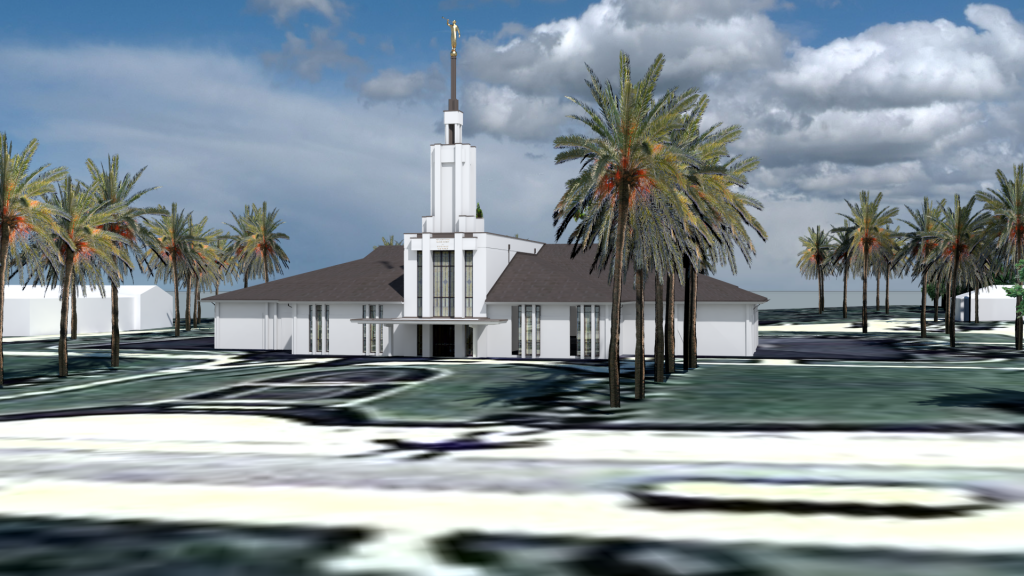
This new method of making statues from fiberglass made them lighter. It made them easier to transport to locations around the globe. They cost less to make, and could be lifted into place by smaller cranes or even helicopters. At the Apia Samoa Temple, when a crane large enough could not be obtained in a timely manner, the workers donned white gloves and lifted the statue into place by hand, such was the success of these new statues.[11]“Taking Temples to Members: Era Comes Closer” Church News, 6 Mar. 1983, 4–5.
Now a temple did not need the heavy structural reinforcement earlier statues required. This allowed for statues to be placed on smaller temples and narrower spires. Even already dedicated temples could be refitted with a statue. The whole process of temple design was changed through the use of the newer, lightweight statue.
As of the end of 2018, copies of this Angel Moroni had been placed atop 95 different temples, making it the single most used statue.
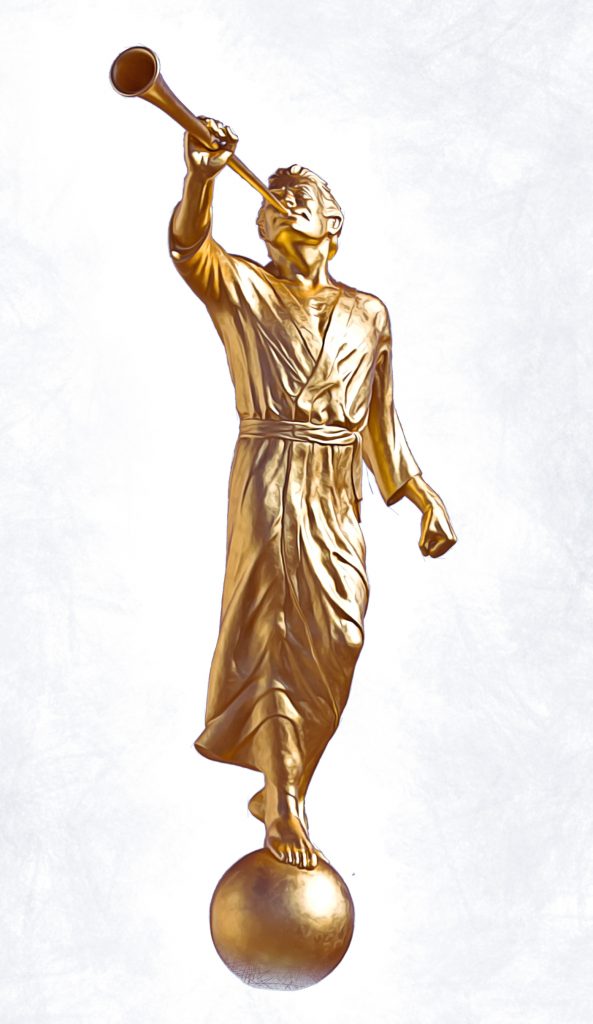
The Wide Grip
The fingers on the right hand are spread apart, not touching, except for the thumb. The thumb overlaps the pointer finger, leaving a visible gap between thumb and horn.

The Smooth Sleeve
The left sleeve on this statue has wrinkles but are not well-defined, giving the sleeve a loose fitting look. Look just above the inside of the left elbow to note the lack of crisp creases.

The Bent Elbow
Unlike its most similar brother, this statue has a lower arm that bends forward slightly at the elbow.

The Straight Cuff
The left cuff of this statue is not windswept, but loose. Additionally, the cuffs on this statue are plain, where as its most similar brother has a visible hem on the cuff.
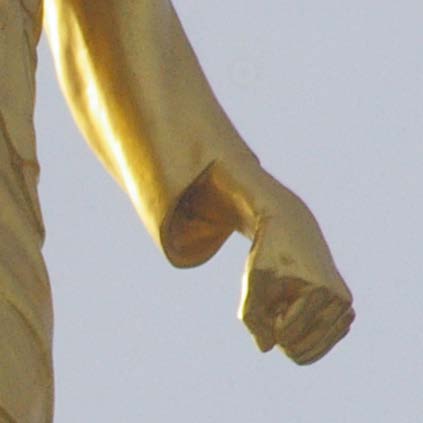
Chapter 3 Navigation
Related Articles
References
| ↑1 | Stecklein, Janelle, “Utah sculptor of Mormon Angel Moroni statues dies at 84,” Salt Lake Tribune, 13 December 2013. |
|---|---|
| ↑2 | Rosner, Jannalee, “”Super Moroni” Statue Almost Appeared on Nauvoo Temple, Sculptor’s Son Recalls.” LDS Living, Mormon Life, 28 October 2016. |
| ↑3 | “Sculptor’s Works Top Temple Towers Worldwide,” Ensign, April 2006. |
| ↑4 | “Sculptor’s Works Top Temple Towers Worldwide.” The Church of Jesus Christ of Latter-Day Saints, The Church of Jesus Christ of Latter-Day Saints, Apr. 2006. |
| ↑5, ↑6, ↑8, ↑9 | Ostler, Shannon W. “How Moroni Statues Are Made.” The Church of Jesus Christ of Latter-Day Saints, The Church of Jesus Christ of Latter-Day Saints, Feb. 1987. |
| ↑7 | Hart, J. L. (1983, September 7). Statues Sculpted in fiberglass. The Church News, pp. 8-13. |
| ↑10 | Based upon personal observation. |
| ↑11 | “Taking Temples to Members: Era Comes Closer” Church News, 6 Mar. 1983, 4–5. |
